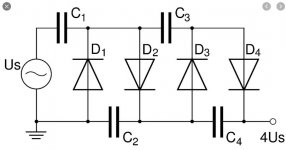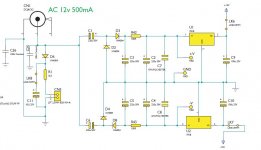Hello everyone,
I'm designing stage microphone preamp with effect loop for a friend based at THAT 1510 & 1646 (or maybe INA217 & DRV135).
XLR microphone input, unbalanced send / return and XLR line output.
But I still can't decide how to handle power supply.
Usually I would use cheap wall-wart style AC transformer with half wave rectifier and LM7815/LM7915 regulators for +/- 15V rails. In my experience this proven to be simple, cheap and low noise.
However, requirement of phantom +48V makes things much more complex.
Basically I want to get internal +15V, -15V and +48V from single, standard and convenient wall wart style supply like 12V DC, 15V AC or 48V DC.
Boost converter from 15V to 48V? This potentially could introduce some imbalance to rails which isn't best thing with half wave rectifier.
With external +48V PSU it is straightforward to get phantom. But what about powering op amps? Maybe some kind of virtual earth rail-splitter? +/- 24V would be too high so voltages still need to be regulated. Single IC split-rail switching converters are expensive, complex and usually works only with low voltages like 5V.
It needs to be rather compact as I want to fit everything inside Hammond 1590BB. I don't want to make it overcomplicated, while keeping limited PCB space and low cost in mind.
I'd be grateful if anyone can suggest me some clever solution.
I'm designing stage microphone preamp with effect loop for a friend based at THAT 1510 & 1646 (or maybe INA217 & DRV135).
XLR microphone input, unbalanced send / return and XLR line output.
But I still can't decide how to handle power supply.
Usually I would use cheap wall-wart style AC transformer with half wave rectifier and LM7815/LM7915 regulators for +/- 15V rails. In my experience this proven to be simple, cheap and low noise.
However, requirement of phantom +48V makes things much more complex.
Basically I want to get internal +15V, -15V and +48V from single, standard and convenient wall wart style supply like 12V DC, 15V AC or 48V DC.
Boost converter from 15V to 48V? This potentially could introduce some imbalance to rails which isn't best thing with half wave rectifier.
With external +48V PSU it is straightforward to get phantom. But what about powering op amps? Maybe some kind of virtual earth rail-splitter? +/- 24V would be too high so voltages still need to be regulated. Single IC split-rail switching converters are expensive, complex and usually works only with low voltages like 5V.
It needs to be rather compact as I want to fit everything inside Hammond 1590BB. I don't want to make it overcomplicated, while keeping limited PCB space and low cost in mind.
I'd be grateful if anyone can suggest me some clever solution.
48V external PSU and a power module that converts that to +/-15V isolated:
TDN 3WI | Traco Power
then connect the common output of the converter to the 0V rail of the +48V supply.
(this is an expensive brand one there are much cheaper china versions).
TDN 3WI | Traco Power
then connect the common output of the converter to the 0V rail of the +48V supply.
(this is an expensive brand one there are much cheaper china versions).
I've had good luck with little DC-DC convertors, but usually going from 12V to 5V or similar. All on a chip! But phantom power is not something I've tried to generate, so will be interested to see what you come up with.
Maybe something based on the MC34063 buck-boost chip? It needs a few external parts, but is flexible.
Maybe something based on the MC34063 buck-boost chip? It needs a few external parts, but is flexible.
MC34063 is limited by 40V maximum voltage. However LM5001 is similar chip and works up to 75V.
I'm not sure how significant is transformer saturation in one direction issue.
This theoretically can happen when rails are not loaded evenly with bipolar half wave power supply. I seen concerns about that in some book but didn't ever had any issues with O2 or my composite headphone amplifier using such PSU.
Whole phantom power should not consume more than 20mA including converter losses.
With 1.5 MHz SMPS I would need to be really careful with EMI. Especially when there is x1000 gain amplifier nearby 😉
Traco TDN 3-4823WI looks almost perfect for my usage but 23 USD is definitely too much.
Closest what I could find at China is WRA4815MD-6W for about 10 dollars. Price is good, isolated output is nice, but how is reliability? This Chinese manufacturer looks solid with complete datasheet. But most offers I can find at Aliexpress are generic/oem without any description.
I'm not sure how significant is transformer saturation in one direction issue.
This theoretically can happen when rails are not loaded evenly with bipolar half wave power supply. I seen concerns about that in some book but didn't ever had any issues with O2 or my composite headphone amplifier using such PSU.
Whole phantom power should not consume more than 20mA including converter losses.
With 1.5 MHz SMPS I would need to be really careful with EMI. Especially when there is x1000 gain amplifier nearby 😉
Traco TDN 3-4823WI looks almost perfect for my usage but 23 USD is definitely too much.
Closest what I could find at China is WRA4815MD-6W for about 10 dollars. Price is good, isolated output is nice, but how is reliability? This Chinese manufacturer looks solid with complete datasheet. But most offers I can find at Aliexpress are generic/oem without any description.
I f you looked at a Comercial PSU circuit for a mixer you will often find that the Phantom power is the output of a voltage doubler Such as this example.
soundcraft spirit folio SX Psu improvememnt
There are voltage doubler circuits for single AC supplies.
There are also dual rail supplies that run off a single AC supply. Maybe a combination of these could be a solution.
soundcraft spirit folio SX Psu improvememnt
There are voltage doubler circuits for single AC supplies.
There are also dual rail supplies that run off a single AC supply. Maybe a combination of these could be a solution.
Attachments
Take +15 & -15 = 30 double that to 60V and use a zener or regulator to step down to 48.
I have a cheap mixing desk which uses just 30V for phantom (rail voltages) and my mikes work fine. Perhaps Your friend doesn't need the whole 48V. Test.
I have a cheap mixing desk which uses just 30V for phantom (rail voltages) and my mikes work fine. Perhaps Your friend doesn't need the whole 48V. Test.
If the wall-wart is outputting AC, a little transformer inside the preamp can step it up for the 48V.
I would build a typical +/-12V supply and then get two of these: SIL-4 DC/DC converter, 1 W, 24 V in/24 V out
Their inputs in // across both rails (so no imbalance issue) and their outputs in serie.
It might not be the cheapest way (3.5€ each) but certainly a compact and easy one.
Their inputs in // across both rails (so no imbalance issue) and their outputs in serie.
It might not be the cheapest way (3.5€ each) but certainly a compact and easy one.
Last edited:
Thank you all for responses. Very appreciated.
Finally decided that I gonna use + 48V and DC / DC converter.
48V SMPS are much easier to get than AC wall-warts and there is nothing worse than ending on stage without replacement PSU at half of the tour
Lots of networking devices uses such supplies. Something like Delta / Cisco 48V 0.375A SMPS can be bought for peanuts. Equivalent of about 2.5 USD at local auction website.
Actually my friend uses dynamic Shure SM58 microphone so phantom wasn't really required.
However I wanted to build something more universal. I know that most mics works just fine with even 30V but my inner perfectionist won't allow me to do that 😀
If anyone's interested in continuation - Balanced microphone preamplifier with effect loop
Finally decided that I gonna use + 48V and DC / DC converter.
48V SMPS are much easier to get than AC wall-warts and there is nothing worse than ending on stage without replacement PSU at half of the tour
Lots of networking devices uses such supplies. Something like Delta / Cisco 48V 0.375A SMPS can be bought for peanuts. Equivalent of about 2.5 USD at local auction website.
Actually my friend uses dynamic Shure SM58 microphone so phantom wasn't really required.
However I wanted to build something more universal. I know that most mics works just fine with even 30V but my inner perfectionist won't allow me to do that 😀
If anyone's interested in continuation - Balanced microphone preamplifier with effect loop
- Home
- Amplifiers
- Power Supplies
- The optimal way of getting +15V, -15V & 48V from single power supply

